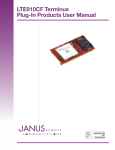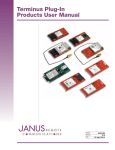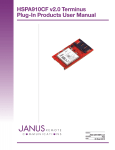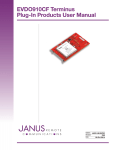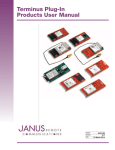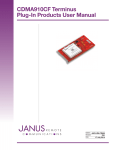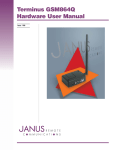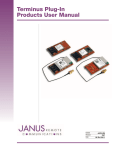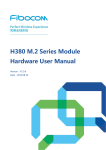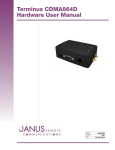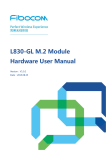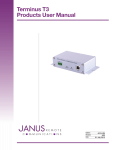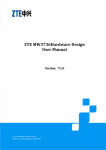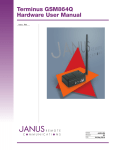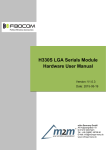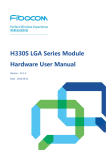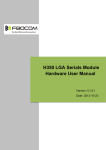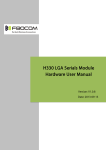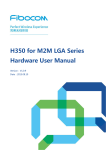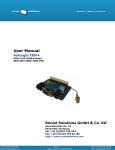Download HSPA910CF User Manual - Janus Remote Communications
Transcript
HSPA910CF Terminus Plug-In Products User Manual Bulletin Revision Date JA03-UM-HSPA P01 28 Aug 2014 TABLE OF CONTENTS TABLE OF CONTENTS and DISCLAIMER............................................................................................................................... 2 1 APPLICABILITY TABLE......................................................................................................................................................... 3 2 REFERENCES....................................................................................................................................................................... 3 2.1 Telit Document List................................................................................................................................................... 3 3 OVERVIEW............................................................................................................................................................................ 4 3.1 Introduction.............................................................................................................................................................. 4 3.2 Preview..................................................................................................................................................................... 4 3.3 HSPA+ Features....................................................................................................................................................... 5 3.4 HSPA+ Block Diagram............................................................................................................................................. 5 4 INTERFACES.................................................................................................................................................................... 6-14 4.1 Serial Interface...................................................................................................................................................... 6-7 4.2 Power Supply........................................................................................................................................................... 8 4.3 Audio Interface......................................................................................................................................................... 9 4.4 Plug-In Pin-Out....................................................................................................................................................... 10 4.5 VRTC Details.......................................................................................................................................................... 11 4.6 GPIO Details...................................................................................................................................................... 12-13 4.7 Internal Interfaces................................................................................................................................................... 13 4.8 LED Status Indicators............................................................................................................................................. 13 4.9 RF Interface............................................................................................................................................................ 14 4.10 SIM Card Interface................................................................................................................................................. 14 4.11 Header Interface Mounting Options....................................................................................................................... 14 4.12 Screw Mounting..................................................................................................................................................... 14 5 HSPA910CF TECHNICAL SPECIFICATIONS................................................................................................................. 15-23 5.1 Electrical Specifications.................................................................................................................................... 15-18 5.2 HSPA+ Mechanical Specifications......................................................................................................................... 19 5.3 Setting Up a Terminal Emulator for use with the HSPA910CF Terminus.......................................................... 20-23 6 DESIGN CONSIDERATIONS............................................................................................................................................... 24 6.1 GSM, CDMA, UMTS, HSPA+ and EV-DO Minimum Required Module Pin Connects........................................... 24 6.2 Debug..................................................................................................................................................................... 24 APPENDICES......................................................................................................................................................................... 25 Approvals............................................................................................................................................................... 25 Safety..................................................................................................................................................................... 25 Antenna Care and Replacement............................................................................................................................ 25 Abbreviations.......................................................................................................................................................... 25 Ordering Information.............................................................................................................................................. 26 Revision History..................................................................................................................................................... 26 DISCLAIMER The information contained in this document is the proprietary information of Connor-Winfield Corporation and its affiliates (Janus Remote Communication). The contents are confidential and any disclosure to persons other than the officers, employees, agents or subcontractors of the owner or licensee of this document, without the prior written consent of Connor-Winfield, is strictly prohibited. Connor-Winfield makes every effort to ensure the quality of the information it makes available. Notwithstanding the foregoing, Connor-Winfield does not make any warranty as to the information contained herein, and does not accept any liability for any injury, loss or damage of any kind incurred by use of or reliance upon the information. Connor-Winfield disclaims any and all responsibility for the application of the devices characterized in this document, and notes that the application of the device must comply with the safety standards of the applicable country, and where applicable, with the relevant wiring rules. ConnorWinfield reserves the right to make modifications, additions and deletions to this document due to typographical errors, inaccurate information, or improvements to programs and/or equipment at any time and without notice. Such changes will, nevertheless be incorporated into new editions of this application note. All rights reserved 2014 Connor-Winfield Corporation HSPA910CF Plug-In Hardware User Guide JA03-UM-HSPA Page 2 Rev: P01 Date: 08/28/14 © Copyright 2014 Janus Remote Communications Specifications subject to change without notice All Rights Reserved See website for latest revision. Not intended for life support applications. 1 APPLICABILITY TABLE Product Part Number HSPA910CF v1.0 2 REFERENCES 2.1 Telit Document List HSPA910CF Our terminal uses Telit module HE910. Please refer to Telit’s website at www.telit.com for the latest information on the HSPA+ HE910 Module. Telit_HE910_Hardware_User_Guide Telit_HE910_Software_User_Guide Telit_HE910_AT_Commands_Reference_Guide Telit_HE910_DVI_App_Note HSPA910CF Plug-In Hardware User Guide JA03-UM-HSPA Page 3 Rev: P01 Date: 08/28/14 © Copyright 2014 Janus Remote Communications Specifications subject to change without notice All Rights Reserved See website for latest revision. Not intended for life support applications. 3 OVERVIEW 3.1 Introduction The User Manual for the Plug-In Terminus devices is intended to illustrate how users can integrate and implement the features of each communication version of the device. The common factors are explained in detail, as well as special considerations and diagrams for each module. The module differences are highlighted in this manual for design considerations for future model placement. 3.2 Preview The Terminus Plug-In Modems are self-contained, multi-band, globally capable, M2M communication devices designed to provide a comprehensive solution to application problems for our M2M customers. They utilize the proven technology of Telit’s certified modules, respectively, for their core communications engines. NavSync’s MS20 module adds the flexibility of GPS to the GSM865CF only. 3.2.1 Functional Description GPS Functionality • An internal GPS solution is available via Telit AT command interface Cellular • HSPA/UMTS/EDGE/GPRS/GSM USB • HS/FS USB 2.0 Device (480Mb/s) Physical Dimensions • Length and width of all Plug-In devices are equal • Heights of different devices will vary 2.300 .100 TYP .047 DIA (49) .050 PIN 49 PIN 26 (TOP VIEW) 1.100 PIN 1 PIN 25 .100 TYP 2.400 HSPA910CF Plug-In Hardware User Guide JA03-UM-HSPA Page 4 Rev: P01 Date: 08/28/14 © Copyright 2014 Janus Remote Communications Specifications subject to change without notice All Rights Reserved See website for latest revision. Not intended for life support applications. 3 OVERVIEW continued 3.3 Features • • • • • • • • • • Penta-Band HSPA+ • GSM Quad Band 850, 900, 1800, 1900 MHz • UMTS/HSPA+ Penta Band 850, 900, 1700, 1900, 2100 MHz EGPRS / WCDMA / HSDPA / HSUPA Protocol Stack 3GPP Release 7 Control via AT commands according to 3GPP TS27.005, 27.007 and Telit customized AT commands Serial port multiplexer 3GPP T27.010 SIM application Tool Kits 3GPP TS 51.014 SIM access profile UDP / TCP / FTP / SMTP Stack Voice and SMS Output power • Class 4 (2W, 33 dBm) @ GSM 850 / 900 • Class 1 (1W, 30 dBm) @ GSM 1800 / 1900 • Class 3 (0.25W, 24 dBm) @ UMTS • Class E2 (0.5W, 27 dBm) @ EDGE 850 / 900 • Class E2 (0.4W, 26 dBm) @ EDGE 1800 / 1900 Sensitivity • -109.5 dBm @ 850/1900 MHz • -109 dBm @ 900 Mhz • -110 dBm @1800 Mhz • -111 dBm @ WCDMA B1/B4/B5 • -110 dBm @ WCDMA B2/B8 • • • • • • • • • Coding scheme 1 to 4 (GPRS) & Modulation Coding scheme 1 to 9 (EDGE) EDGE Class 33, MS Class B Data • HSPA: DL: Up to 21.0Mbps, UL: Up to 5.76Mbps • WCDMA: DL: Up to 384kbps, UL: Up to 384kbps • EDGE: DL: Up to 296kbps, UL: Up to 236.8kbps • GPRS: DL: Up to 107kbps, UL: Up to 85.6kbps • Asynchronous non transparent CSD up to 9.6 kbps DARP I Dimensions: TBD Operational Temperature Range: -40°C to 85°C Internal Switching Regulator: • Input Voltage Range: 3.0 to 5.25Vdc (5Vdc nominal) • Supply disable via terminal input pin SIM Card • Standard locking SIM card socket • Optional SIM chip GSM, GSM RX Diversity, and GPS available via Murata GSC miniature RF connector 3.4 Block Diagram HSPA910CF 5 VDC Switching Regulator ENABLE 1.8v PWRMON Enable LDO 2.85v VAUX 1.8v UART (AT) 2.85v UART (AT) 1.8v UART (TRACE) 2.85v UART (TRACE) 2.85v PWRMON 1.8v PWRMON Translator Enable 1.8v GPIO 2.85v GPIO (3-7) ON/OFF RESET TELIT HE910 UMTS/HSPA+ 1.8v VRTC GPIO2 : GPS/USER LED GPIO1 : Cellular LED USB 1.8v DVI 1.8v GPIO9 / I2C SDA 1.8v GPIO10 / I2C SCL 1.8v GPIO 1.8v UART (AT) 1.8v UART (TRACE) 1.8v PWRMON * SIM CARD * Optional SIM I.C. Figure 1 HSPA910CF Block Diagram HSPA910CF Plug-In Hardware User Guide JA03-UM-HSPA Page 5 Rev: P01 Date: 08/28/14 © Copyright 2014 Janus Remote Communications Specifications subject to change without notice All Rights Reserved See website for latest revision. Not intended for life support applications. 4 INTERFACES 4.1 Serial Interface 4.1.1 UART Serial Port The serial interface is a CMOS level UART. Default Communications settings for this port are as follows: • Baud Rate: 115.2 kbps • Bits: 8 • Stop Bits: 1 • Parity: None • Hardware Handshaking: Yes The HSPA910CF does not support autobaud, and must be changed via the AT+IPR command. It is defaulted to 115200 bps Note: If you are not using Hardware Handshaking, please note that RTS must be connected to GROUND for proper communications where flow control is unused. 4.1.1.1 UART Level Translation The electrical limits for the UART are listed in the individual modem sections. Please be aware of these limits, as operating outside of them may damage the unit. If the limits must be exceeded, level translation can be used. An example of basic translation for RXD/TXD only is found below. Figure 2 UART Level Translation Example Although an external source for the level translation can be used, VAUX can be used as the reference instead. However, because some Plug-In Modems require AT commands to control VAUX, PWRMON may be used as an enable to an external reference. Do not use PWRMON directly as the reference. 4.1.2 USB Port The Plug-In modems that are USB ready include an integrated universal serial bus (USB) transceiver, compliant with USB 2.0 specifications. High data rates for the USB enabled modems are only available over the USB interface, as the UART has a maximum baud rate of <1Mbps. In order for proper power-up of the Plug-In Modems, the USB_VBUS line MUST be disconnected until the unit is otherwise fully powered and on. If the USB_VBUS line is attached and powered before the main power is brought up and the module turned on, power sequencing issues may occur. Note: You must implement the USB interface in order to locally update radio firmware for CDMA and UMTS applications. The GSM865CF does not have USB port available. HSPA910CF Plug-In Hardware User Guide JA03-UM-HSPA Page 6 Rev: P01 Date: 08/28/14 © Copyright 2014 Janus Remote Communications Specifications subject to change without notice All Rights Reserved See website for latest revision. Not intended for life support applications. 4 Interfaces continued 4.1.2 USB Port continued 4.1.2.1 USB Connection Diagram Figure 3 USB Connection Diagram 1 4.1.2.2 USB VBUS Switch 2 3 4 USB_VBUS is input, when VBUS_ENABLE is HIGH the 5v signal will be passed to TERMINUS_VBUS, turning the USB ON. Q1 P-Channel MOSFET A USB_VBUS 2 D 3 TERMINUS_VBUS R1 10K Ohm 5% G 1 S B d R2 1.5K Ohm 5% 3 1 VBUS_ENABLE R3 10K Ohm 5% R-680-G s 2 Q2 N-Channel MOSFET 1 g Figure 4 USB VBUS Switch Example C HSPA910CF Plug-In Hardware User Guide JA03-UM-HSPA Page 7 Rev: P01 Date: 08/28/14 © Copyright 2014 Janus Remote Communications Specifications subject to change without notice All Rights Reserved See website for latest revision. Not intended for life support applications. 4 Interfaces continued 4.2 Power Supply The module’s power supply accepts input voltages from 4.75Vdc to 5.25Vdc and requires a nominal current sourcing capacity of 5W (maximum 10W). Power Supply A good understanding of the load transients is required in order to meet the power requirements of a cellular radio. Power supply design, thermal management and layout are outside the scope of this document. Please refer to power supply manufacturers for product documentation and design application notes. Cellular Load Transients Cellular radios use a mix of modulation schemes including, but not limited to, TDMA and CDMA. In GSM/ GPRS systems the transmission and reception of data is achieved via Time Division Multiple Access (TDMA). TDMA transmission is made up of RF bursts that cause 2A current pulses at the supply input of the cellular radio. These current pulses occur at a frequency of 216 Hz and can persist for 1.2 to 2.4ms. On Board Regulator This Terminus Plug-In module is designed with a switching regulator to power the cellular radio. The regulator can receive an input voltage of 3.7 to 5.25VDC to maintain regulation, but can also accept down to 3.3VDC, in which regulation is bypassed. This is useful for battery operated applications. Note that an input voltage below 4.75VDC is outside of rated specifications and thus not supported by Janus. Note: The regulator input is capable of withstanding 6VDC Maximum. This is outside the recommended operating voltage of the Plug-In modules but but is helpful to know when designing input transient circuitry. Plug-In Module Input Supply Requirements The current values are given in average units due to the pulsed nature of the transmission scheme. It is recommended that your supply source the full peak current value of the transmission pulse in order to maintain proper cellular operation. The use of bulk output capacitors on your supply allows for a less powerful supply. 4.3 Audio Interface 4.3.1 HSPA910CF The 910CF modules use a DVI audio interface which will not work with the analog audio inerface of the other Terminus Plug-In modems. The HSPA910CF supports both I2S and PCM, master and slave modes, and can use a CODEC to convert the interface to analog. Below is a block diagram based on DVI and the max 9867 CODEC with GPIO 9 and 10 being used for I2C control of the CODEC. Please refer to the referenced DVI Application Notes for full information and example schematics utilizing the MAX9867 Audio CODEC. Figure 5 DVI Block Diagram HSPA910CF Plug-In Hardware User Guide JA03-UM-HSPA Page 8 Rev: P01 Date: 08/28/14 © Copyright 2014 Janus Remote Communications Specifications subject to change without notice All Rights Reserved See website for latest revision. Not intended for life support applications. 4 Interfaces continued 4.4 Plug-In Pin-Out PIN PIN NAME DESCRIPTION STANDARD I/O SIGNAL POWER- ON STATE PULL TYPE N/A NOTE 1 SUPPLY Positive Supply Input Power N/A 2 SUPPLY Positive Supply Input Power N/A N/A 3 ENABLE SUPPLY Enable/Disable Supply Input N/A PULL-UP to Vin: 681k 1 4 RXD UART - Transmit Line Output N/A N/A 6 5 DSR UART - Data Set Ready Output N/A N/A 6 6 CTS UART - Clear to Send Output N/A N/A 6 7 RING UART - Ring Indicator Output N/A N/A 6 8 DCD UART - Data Carrier Detect Output N/A N/A 6 9 TXD UART - Receive Line Input N/A N/A 6 10 DTR UART - Data Terminal Ready Input N/A N/A 6 11 RTS UART - Request to Send Input N/A N/A 4 12 GROUND Supply Reference Power N/A N/A 13 TRACE_TX Debug UART - Transmit Line Output N/A N/A 6 14 TRACE_RX Debug UART - Receive Line Input N/A N/A 6 15 USER LED USER LED Output N/A N/A 6 16 CELLULAR LED Cellular Status Output N/A N/A 6 17 SERVICE Unused N/A N/A N/A 5 18 PWRMON Power Monitor Output Output N/A PULL-DOWN:1M 6 19 ON_OFF Toggle Cellular Radio On Off State Input N/A PULL-UP to VTRC: 47k 1 20 RESET Reset Cellular Radio Input N/A PULL-UP: 47k 1 21 DVI WAO DVI Word Alignment WCLK N/A N/A 6 22 DVI RX DVI Received Data 23 DVI TX DVI Transmitted Data 24 DVI CLK NDVI Data Clock BCLK 25 GROUND Supply Reference Power 26 GROUND Supply Reference Power N/A N/A 27 USB_D- USB Differential Data (-) CMOS Bi-Direction N/A N/A 28 USB_D+ USB Differential Data (+) CMOS Bi-Direction N/A N/A 29 USB_VBUS USB Supply Power N/A N/A 30 USB_ID Future Use Analog Input N/A N/A 31 I2C_SDA 12C Data CMOS Bi-Direction INPUT N/A 32 I2C_SCL 12C Clock CMOS Bi-Direction INPUT N/A 33 GPS_RX Unused N/A N/A N/A 5 34 GPS_TX Unused N/A N/A N/A 5 35 GPS_RESET Unused N/A N/A N/A 5 36 GPIO_7 General Purpose I/O Bi-Direction INPUT N/A 6 37 GPIO_6 General Purpose I/O Bi-Direction INPUT N/A 6 38 GPIO_5 General Purpose I/O Bi-Direction INPUT N/A 6 39 GROUND Supply Reference Power N/A N/A 40 GPIO_4 General Purpose I/O Bi-Direction INPUT N/A 6 41 GPIO_3 General Purpose I/O Bi-Direction INPUT N/A 6 42 GPIO_2 Unused N/A N/A N/A 5 43 GPIO_1 Unused N/A N/A N/A 5 44 DAC Unused N/A N/A N/A 5 45 ADC2 Unused N/A N/A N/A 5 46 ADC1 Analog to Digital Converter Analog Input N/A N/A 6 47 VRTC Cellular Radio External RTC Supply Power N/A N/A 48 VAUX Reference Voltage Analog Output N/A N/A 49 GROUND Supply Reference Power N/A N/A SDIN N/A N/A 6 SDOUT N/A N/A 6 N/A N/A 6 N/A N/A 2,3 Notes: 1. It is required that this input be controlled by an Open Collector/Drain Output. Do not use an external pull-up resistor; a pull-up is included internal to the module. 2. Not currently implemented 3. USB On The Go: Analog input used to sense whether a peripheral device is connected and determine the peripheral type; a host or a peripheral. 4. RTS must be connected to GROUND if flow control is not used. 5. Not used on the HSPA910CF 6. Refer to the electrical specifications for I/O levels HSPA910CF Plug-In Hardware User Guide JA03-UM-HSPA Page 9 Rev: P01 Date: 08/28/14 © Copyright 2014 Janus Remote Communications Specifications subject to change without notice All Rights Reserved See website for latest revision. Not intended for life support applications. 4 Interfaces continued 4.5 VRTC Details The VRTC pin brings out the real time clock supply, which is separate from the rest of the part. This allows only the RTC to be ON when all other parts of the device are OFF. A backup capacitor can be added to this pin to increase RTC autonomy while powering the device from a battery. The CDMA910CF cannot take advantage of the VRTC functionality. No devices should be powered from this pin. Equations: C = 3600 * [(Btime * IRTC)/(VRTC - VRTCmin)] Btime = [C * (VRTC - VRTCmin)/(IRTC * 3600)] Where: VRTC – The Starting voltage of the capacitor (Volt) VRTCmin – The minimum voltage acceptable for the RTC circuit. (Volt) IRTC (Ampere) – The current consumption of the RTC circuitry when VBATT = 0 Btime - Backup Time (Hours) C = Capacitor value (Farads) Values for the GSM865CF/CDMA864CF/UMTS864CF VRTC = 2.05v Nominal VRTC minimum input voltage to function = 1.1v IRTC = 10uA nominal Values for the HSPA910CF VRTC = 1.8v Nominal VRTC minimum input voltage to function = 1.1v IRTC = 2uA nominal Values for the EVDO910CF VRTC = 3.1v Nominal VRTC minimum input voltage to function = 2.0v IRTC = 1.1uA nominal Values for the CDMA910CF VRTC = N/A VRTC minimum input voltage to function = N/A IRTC = N/A For Example, using the HSPA910CF numbers: Btime = 96 hours (4 days) C = 1.0F 4.6 GPIO Details Terminus GPIO are configurable as input, output, and special function. Configuration is controlled by the customer specific application via AT commands. The following table describes GPIO configuration options. GPIO Configuration Alternate Function ON_OFF State Input / Output Input / Output Input / Output Input / Output Input / Output Input / Output Input / Output Status LED User LED N/A N/A N/A N/A N/A pull-up pull-up pull-down pull-down pull-down pull-up pull-down 1 2 3 4 5 6 7 HSPA910CF Plug-In Hardware User Guide JA03-UM-HSPA Page 10 Rev: P01 Date: 08/28/14 © Copyright 2014 Janus Remote Communications Specifications subject to change without notice All Rights Reserved See website for latest revision. Not intended for life support applications. 4 Interfaces continued 4.6 GPIO Details continued 4.6.1 Using a GPIO Pad as INPUT The GPIO pads, when used as inputs, can be connected to a digital output of another device and report its status, provided this device has interface levels compatible with the Voltage levels of the GPIO of the module. 4.6.2 Using a GPIO Pad as OUTPUT The GPIO pads, when used as outputs, can drive CMOS digital devices or compatible hardware. When set as outputs, the pads have a push-pull output. 4.6.3 Analog to Digital Converter ADC Description 1Analog to digital converter input 4.6.4 I2C The I2C interface is an alternate function of the modem’s GPIO, for the HSPA910CF, those two signals are designated for GPIO 9 (SDA) and GPIO 10 (SCL) and are 1.8V logic level to match the DVI interface for easy usage with a codec. The signals are not pulled up on the Plug-In module and must be pulled up externally as they may also be used as spare GPIO. Please reference the Telit AT Command Guide for details on the I2C commands. 4.6.5 ENABLE Pin Input Logic State High-Z 0 Description Active state Shutdown Notes: 1. It is required that this input be controlled by an open collector/drain output. Do not use an external pull-up resistor, a pull-up to VIN is included internal to the Terminus. 2. The ENABLE pin is offered as a means to turn off the on-board regulator for when a full power cycle is needed or an ultra low power state is required. The ENABLE pin is not intended to be used as a means of turning the Terminus off. use the ON/OFF pin to turn the Terminus on or off. 3. Shut down state must be held for 10ms before returning to active state. 4. The regulator is operational 2mS after active state is entered. Figure 6 Enable Pin HSPA910CF Plug-In Hardware User Guide JA03-UM-HSPA Page 11 Rev: P01 Date: 08/28/14 © Copyright 2014 Janus Remote Communications Specifications subject to change without notice All Rights Reserved See website for latest revision. Not intended for life support applications. 4 Interfaces continued 4.6 GPIO Details continued 4.6.8 RESET Pin Input Logic State High-Z 0 Description Active state Reset state Notes: 1. It is required that this input be controlled by an open collector/drain output. Do not use an external pull-up resistor, a pull-up is included internal to the Terminus. 2. The RESET pin is offered as a means to reset the Terminus when and if the Terminus becomes unresponsive. The RESET pin is not intended to be used as a means of turning the Terminus off. Use the ON/OFF pin to turn the Terminus on or off. 3. RESET state must be held for at least 200ms before returning to active state. Figure 7 Reset Pin Diagram 4.6.9 ON/OFF Pin Input Logic State Description High-Z Terminus turned ON or OFF after input returns to this state. 0 Toggle Terminus ON or OFF Notes: 1. It is required that this input be controlled by an open collector/drain output. Do not use an external pull-up resistor, a pull-up is included internal to the Terminus. 2. The ON/OFF pin is offered as a means to power-on and power-down the Terminus. When the Terminus powers-down it informs the cell tower that it is powering down and will not be communicating with the tower any more. This is considered a controlled power-down. 3. After toggling the power state of the Terminus, wait until PWRMON indicates chosen state before toggling the power state again. 4. To turn ON the plug-in module, the ON_OFF input must be tied low for 3 second then released. 5. To turn OFF the plug-in module, the ON_OFF input must be tied low for 2 seconds then released. 6. Optionally the Terminus may be powered-down with the use of AT commands. 7. It is required to stop driving terminal inputs high when turning ON the Plug-In module by floating or bringing them low. If this is not done, power sequencing issues may occur. Figure 8 On / Off Pin Diagram HSPA910CF Plug-In Hardware User Guide JA03-UM-HSPA Page 12 Rev: P01 Date: 08/28/14 © Copyright 2014 Janus Remote Communications Specifications subject to change without notice All Rights Reserved See website for latest revision. Not intended for life support applications. 4 Interfaces continued 4.6 GPIO Details continued 4.6.10 PWRMON Pin Output Logic State Description 0 1 Terminus powered-down Terminus powered-on Notes: 1. Used in conjunction with ON/OFF pin to control power-on and power-down state. 2. During a power down, it is required to stop driving terminal inputs high by floating or bringing them low. If this is not done, the PWRMON output will not transition low. On the GSM865CF and HSPA910CF, this will cause the VAUX output to remain active. 4.6.11 VAUX A regulator power supply output that is provided in order to supply small devices from the module itself. When PWRMON is HIGH, VAUX will be ON. When PWRMON is LOW, VAUX will be OFF. 4.7 User LED The HSPA910CF comes equipped with GPS functionality that is built into the cellular radios. However, the cellular radios have no GPS status output for driving an LED. Instead, this module has GPIO2 connected to the User LED pin of the Terminus. The user application can use this to control an LED or act as an additional GPIO. See figure 10 for recommended connection of an LED. 4.8 LED Status Indicators The LED Status output is used to drive an external LED to give feedback on the current operation. See figure 10 for recommended connection of an LED. For the HSPA910CF, this is an alternate function of GPIO1 and must be set via the AT#GPIO command. The status is defined below. 4.8.1 Cellular LED Status (HSPA910CF) LED Status Device Status Permanently Off Cellular radio is off Permanently On On/Searching Slow Blinking (0.3 sec on / 2.7 sec off) Registered Fast Blinking (0.5 sec on / 0.5 sec off) Shutting down Figure 9 LED Indicators Diagram HSPA910CF Plug-In Hardware User Guide JA03-UM-HSPA Page 13 Rev: P01 Date: 08/28/14 © Copyright 2014 Janus Remote Communications Specifications subject to change without notice All Rights Reserved See website for latest revision. Not intended for life support applications. 4 Interfaces continued 4.9 RF Interface There are three RF interfaces on the HSPA910CF. A cellular, GPS, and RX diversity connector. The specifications and requirements for these are as follows: Note: You must access the RF connections via the SMT GSC connections if they do not include a GSC to SMA connector. These signals are NOT electrically connected elsewhere on the board. 4.9.1 HSPA910CF Antenna Interface Type: Murata GSC - MALE (Murata Part #MM9329-2700RA1) Pin Description Center Pin Outer Conductor RF signal Signal ground 4.9.2 Certified HSPA+ Antenna TBD 4.10 SIM Card Interface The SIM Card Interface allows the Terminus to accept the subscriber card provided by the cellular telephone provider. It can accommodate a 1.8V or 3.0V SIM card and complies with the Phase 2 GSM 11.14 standard. Optional SIM IC. Consult factory representative. 4.11 Header Interface Mounting Options The Plug-In Modules’ header pin length has been chosen to allow for direct solder mount to a PCB of standard thickness. If the user wishes to socket the Plug-In Module, they may do so as well by using the below part numbers for reference: Samtec 25 pin header: TSM-125-04-L-SV-A Samtec 24 pin header: TSM-124-04-L-SV-A Mating Samtec 25 pin connector: SLW-125-01-G-S Mating Samtec 24 pin connector: SLW-124-01-G-S Please note there are no Samtec SMT single row mating connectors. The only mating connector available is the above listed THT version. 4.12 Screw Mounting The HSPA910CF allows for the use of a #4 machine screw to help keep a socketed module in place where environmental variables may cause problems otherwise. If the user wishes to have a stand-off underneath the module to help alleviate possible stress from mounting hardware, below are the Janus part numbers and associated drawings for an available solution. 4-40 Hex Female Stand-off: MC-0356-G 4-40 3/16” Pan Head Phillips Machine Screw: MC-0357-G Figure 10 Screw Diagram HSPA910CF Plug-In Hardware User Guide JA03-UM-HSPA Page 14 Rev: P01 Date: 08/28/14 © Copyright 2014 Janus Remote Communications Specifications subject to change without notice All Rights Reserved See website for latest revision. Not intended for life support applications. 5 HSPA910CF TECHNICAL SPECIFICATIONS 5.1 Electrical Specification 5.1.1 Absolute Maximum Ratings Parameter Min Typ Max Unit VIN (DIGITAL INPUTS 2.85V CMOS) VIN (DIGITAL INPUTS 1.8V CMOS) Storage Temperature Supply (+) referenced to Supply (-) -0.5 -0.3 -40 0 - - - - 3.35 3.1 85 6 Volt Volt °C Volt Note Operation of the device at these or any other conditions beyond those listed under Recommended Operating Conditions is not implied. Exposure to Absolute Maximum Rating conditions for extended periods of time may affect device reliability. 5.1.2 Recommended Operating Conditions Parameter Min Typ Max Unit Temperature Supply (+) referenced to Supply (-) VAUX Output VAUX Current -40 4.75 - - - 5.0 2.85 - 85 5.25 - 100 °C Volt Volt mA 5.1.3 Power Supply Mode Average (mA) POWERED DOWN Terminal Disabled Cellular Radio Off < 15µA 0.4 Note Mode Description Terminal disabled (ENABLE SUPPLY = 0) Cellular module powered but switched off via ON_OFF pin (PWRMON=0) Mode Average (mA) IDLE MODE Mode Description GPS OFF AT+CFUN=1 AT+CFUN=4 AT+CFUN=5 WCDMA 13.8 Idle, no call in progress. Full functionality of the module GSM 13.9 WCDMA 14.4 Disabled TX and RX; module is not registered on the network GSM 14.4 WCDMA 3.4CFUN=5 full functionality with power saving; Module registered on GSM 3.3 the network can receive incoming call sand SMS AT+CFUN=7 WCDMA 10.0CFUN=5 full functionality with power saving; Module registered on GSM 9.2 the network can receive incoming call sand SMS WCDMA/HSDPA GPS OFF in HSPA910CF WCDMA Voice TBD voice channel WCDMA data 130.2 data channel GSM GSM Voice TBD GSM voice channel GPRS Class 12 129.3 GPRS data channel GPS ON AT+CFUN=1 WCDMA 35.5 GSM 37.2 Idle, no call in progress. Full functionality of the module AT+CFUN=4 WCDMA 36.8 Disabled TX and RX; module is not registered on the network GSM 37.6 AT+CFUN=5 WCDMA 28.9 Disabled TX and RX; module is not registered on the network GSM 30.0 AT+CFUN=7 WCDMA 33.8 Disabled TX and RX; module is not registered on the network GSM 34.3 WCDMA/HSDPA WCDMA Voice TBD WCDMA voice channel WCDMA Data 156 WCDMA data channel GSM GSM Voice TBD GSM voice channel GPRS/EDGE Class 12 152 GPRS data channel * except external active GPS antenna. * Data taken with USB disconnected. HSPA910CF Plug-In Hardware User Guide JA03-UM-HSPA Page 15 Rev: P01 Date: 08/28/14 © Copyright 2014 Janus Remote Communications Specifications subject to change without notice All Rights Reserved See website for latest revision. Not intended for life support applications. 5 HSPA910CF TECHNICAL SPECIFICATIONS continued 5.1 Electrical Specification continued 5.1.4 I/O Levels 5.1.4.1 1.8v Standard Interface Levels (DVI, I2C, GPS LED) Parameter Min Typ Input Voltage High - Vih Input Voltage Low - Vil Output Voltage High - Voh Output Voltage Low - Vol Typical Current Source/Sink = 100uA/1uA 1.5 0 1.6 0 5.1.4.2 2.85v Standard Interface Levels (UART, GPIO) Parameter Min Max Unit - - - - 1.9 0.35 1.9 0.2 Volt Volt Volt Volt Typ Max Unit 1.85 0 2.45 0 - - - - 2.85 0.99 2.85 0.4 Volt Volt Volt Volt Min Typ Max Unit 1.6 0 - - 1.9 0.2 5.1.4.4 ADC Input Levels Parameter Min Typ Max Input Voltage Range AD Conversion Input Resistance Input Capacitance 0 - 1M - - - - 1 1.2 10 - - 5.1.4.5 Reset Pin Input Levels Parameter Min Typ Max Unit Input Voltage High - Vih Input Voltage Low - Vil 1.5 0 - - 1.9 0.35 Volt Volt Input Voltage High - Vih Input Voltage Low - Vil Output Voltage High - Voh Output Voltage Low - Vol Typical Current Source = 100uA/1uA 5.1.4.3 Cellular LED Output Levels Parameter Output Voltage High - Voh Output Voltage Low - Vol Typical Current Source = 100uA Note Note Note Volt Volt Unit Note Volt Bits Ohm pF Note It is required that this input be controlled by an Open Collector/Drain Output. Do not use an external pull-up resistor, a pull-up is included internal to the Terminus. HSPA910CF Plug-In Hardware User Guide JA03-UM-HSPA Page 16 Rev: P01 Date: 08/28/14 © Copyright 2014 Janus Remote Communications Specifications subject to change without notice All Rights Reserved See website for latest revision. Not intended for life support applications. 5 HSPA910CF TECHNICAL SPECIFICATIONS continued 5.1 Electrical Specification continued 5.1.5 HSPA+ Cellular Antenna Specifications: 5.1.5.1 Antenna Specifications Parameter Description Frequency Range Bandwidth Gain Impedance Input Power VSWR Absolute Max VSWR Recommended Depending on frequency bands provided by the network operator, the customer should use the most suitable antenna for those frequencies. 70MHz in GSM850 80 MHz in GSM900 170 MHz in DCS & 140 MHz PCS 70 MHz in WCDMA850 80 MhHz in WCDMA900 460 MHz in WCDMA1700 140 MHz in WCDMA1900 250 MHz in WCDMA2100 Gain < 3dBi 50Ω >33 dBm (2W) peak power in GSM >24 dBm Average power in WCDMA ≤ 5:1 ≤ 2:1 5.1.6 HSPA910CF GPS Antenna Specifications: 5.1.6.1 Antenna Specifications Parameter Description Input Voltage Range Frequency Range Gain Impedance VSWR Current Consumption 2.85V 1575.42± 2 MHz =< 15dB overall at the connector (Antenna and LNA included). 50 ohm TBD 30mA Max, 20mA Typ. HSPA910CF Plug-In Hardware User Guide JA03-UM-HSPA Page 17 Rev: P01 Date: 08/28/14 © Copyright 2014 Janus Remote Communications Specifications subject to change without notice All Rights Reserved See website for latest revision. Not intended for life support applications. 5 HSPA910CF TECHNICAL SPECIFICATIONS continued 5.1 Electrical Specification continued 5.1.7 USB Transceiver Specifications Parameter Comments Min Typ Max Unit USB_VBUS Supply voltage 4.5 5.0 5.25 Supply current 25 Input levels for low-/full speed Receiver threshold (single-end) 0.8 - 2.0 Differential input sensitivity |D+ - D-|, Vin = 0.8V to 2.5V 0.2 - - Differential common-mode range Includes VDI 0.8 - 2.5 Output levels for low-/full speed Low RL = 1.5 kΩ to 3.6 V - - 0.3 High RL – 15 kΩ to GND 2.8 - 3.6 Output signal crossover voltage 1.3 - 2.0 Terminations Internal pull-up resistor VTRM to D+, VTRM to D- 1.425 1.5 1.575 Internal pull-down resistor D= to GND, D- to GND 14.3 15 24.8 High-Z state output impedance 0 V< VDD< 3.6 V; measured at D+ and D- pins to GND 300 - - Termination voltage An internal supply voltage, VTRM 3.0 3.3 3.6 Driver characteristics – full speed Transition time: Rise time CL = 50 to 125 pF 4 - 20 Fall time CL – 50 to 125 pF 4 - 20 Rise/fall time matching 90 - 111 Series output resistance D+, D- 28 33 44 Driver characteristics – low speed Transition time: Rise time CL = 50 to 600 pF 75 - 300 Fall time CL – 50 to 600 F 75 - 30 Rise/fall time matching 80 - 125 HSPA910CF Plug-In Hardware User Guide JA03-UM-HSPA Page 18 Rev: P01 Volt mA Volt Volt Volt Volt Volt Volt kΩ kΩ kΩ Volt ns ns % Ω ns ns % Date: 08/28/14 © Copyright 2014 Janus Remote Communications Specifications subject to change without notice All Rights Reserved See website for latest revision. Not intended for life support applications. 5 HSPA910CF TECHNICAL SPECIFICATIONS continued 5.2 Mechanical Specification Figure 11 HSPA910CF Mechanical Dimensions HSPA910CF Plug-In Hardware User Guide JA03-UM-HSPA Page 19 Rev: P01 Date: 08/28/14 © Copyright 2014 Janus Remote Communications Specifications subject to change without notice All Rights Reserved See website for latest revision. Not intended for life support applications. 5 HSPA910CF TECHNICAL SPECIFICATIONS continued 5.3 Setting Up a Terminal Emulator for Use With the HSPA910CF Terminus 5.3.1 Set Up To interface with the module, connect the serial interface to a PC and use a terminal emulation program such as Microsoft® Hyperterminal. Set the interface parameters as follows: • Baud Rate: 115.2 kbps • Bits: 8 • Stop Bits: 1 • Parity: None • Hardware Handshaking: Yes 5.3.1.1 Test the Emulator Set Up • Enter AT<cr> from terminal and wait for OK Note that Autobaud is not supported on the HSPA910CF Terminus. If you are utilizing the serial interface and you wish to change the baud rate on the module, you must use AT+IPR. You must also change the rate in the host UART (i.e. HyperTerminal) to match the new baud rate. If these do not match you will not be able to send AT commands to the module through the serial port. The Terminus is by default set to 115.2 kbps. 5.3.1.2 Verify Your Terminal and Firmware Version • Enter AT+CGMM and wait for the response The response will be the Telit module’s model number without a command echo. • Enter AT+CGMR and wait for the response The response will be the Telit module’s current firmware without a command echo. Please confirm your model and firmware with the one listed in section 2.1 5.3.2 Powering ON/OFF 5.3.2.1 Turn the module ON through the following method: • Pull ON/OFF signal (Pin 19) to ground for three (3) seconds, then release. The Terminus module is fully operational after 4 seconds. Logging onto a network may take longer than this and is outside the control of the Terminus. 5.3.2.2 There are two ways to switch OFF the module as described below. • Use the appropriate AT command (AT#SHDN) • Pull ON/OFF signal (Pin 19) to ground for three (3) seconds, then release. HSPA910CF Plug-In Hardware User Guide JA03-UM-HSPA Page 20 Rev: P01 Date: 08/28/14 © Copyright 2014 Janus Remote Communications Specifications subject to change without notice All Rights Reserved See website for latest revision. Not intended for life support applications. 5.3 HSPA910CF GETTING STARTED continued 5.3 Setting Up a Terminal Emulator for Use With the HSPA910CF Terminus continued 5.3.3 Setting Up Service – Network Settings 5.3.3.1 Set Up The network settings for the Terminus will vary depending on the cellular carrier you are using. Below are two of the North American Cases for these settings. For T-mobile® & MNVO (Raco®, Sensor Logic®, Nexaira® Jasper Wireless®) enter: • AT#SELINT=2 //use of most recent AT command set • AT#STIA=2,10 or AT#STIA=1 // enable SAT – SIM Application Tool-Kit • AT#BND=3,3 // default bands to 850/1900/2100 • AT#AUTOBND=1 // enable Quad band system selection • AT&P0 // save profile • AT&W0 // save setting • AT#ENS=0 For AT&T/Cingular® & MNVO (Kore®, Aeris®, nPhase®) enter: • AT#SELINT=2 //use of most recent AT command set • AT#ENS=1 // AT&T/Cingular configuration (SAT, BND, AUTONBND, PLMNMODE, plus Cingular® specific ENS requirements) If Terminus is being used in a different country or with a different carrier please refer to Telit AT command refer¬ence document regarding the use of the AT#BND command to set the proper frequency band). Important: After entering either of the sets of settings above power the Terminus OFF and then ON. It is now ready for use. 5.3.3.2 Check Network Status (assuming you have a valid SIM card installed) Enter AT+CREG? <cr> And wait for response. Response will be +CREG:0,1 or +CREG: 0,5 meaning the device is registered to the home network or roaming, respectively. If response is different than this, please refer to the Telit AT command reference document for more information. 5.3.3.3 Check Signal Quality Enter AT+CSQ<cr> And wait for response +CSQ:<rssi>,<ber> <rssi> Signal Strength 99 Not known or not detectable 0-31 dBm = (rssi * 2) –113 Example: A result of 31 indicates -51dBm or greater. An rssi value of >=10 in typical applications is fine and you will usually see about 12-20 in normal to good signal, but note that worst case it can be lower, still register and perform normal functions. 5.3.4 Making a Voice Call 5.3.4.1 Set Up Voice call mode allows you to use a telephone handset to communicate with a properly equipped subscriber unit. • Set the call mode to voice Enter AT+FCLASS=8<cr> and wait for response OK • Dial the phone number Enter ATD <8885551234>; <cr> • To disconnect the call enter ATH<cr> HSPA910CF Plug-In Hardware User Guide JA03-UM-HSPA Page 21 Rev: P01 Date: 08/28/14 © Copyright 2014 Janus Remote Communications Specifications subject to change without notice All Rights Reserved See website for latest revision. Not intended for life support applications. 5.3 HSPA910CF GETTING STARTED continued 5.3 Setting Up a Terminal Emulator for Use With the HSPA910CF Terminus continued 5.3.5 Sending an SMS 5.3.5.1 Set Up SMS (Select Message Service) mode allows you to send a text message (max 160 characters) to a SMS capable subscriber unit. • Set the SMS mode to text. This must be entered every power cycle. AT+CMGF=1<cr> • To enter the receiving subscriber unit phone number and message enter: AT+CMGS=”8885551234” Wait for response”>” then enter message text Enter “ctrl z” <cr> to end the message 5.3.6 Making a GPRS Data Call 5.3.6.1 Set Up GPRS is a data service that uses Packet Data Protocol (PDP). • Set up the PDP context parameters Enter AT+CGDCONT=1, “IP”, “APN”, “0.0.0.0”,0,0<cr> Where APN is specific to the service provider being used. • Activate the PDP context Enter AT#SGACT=1,1,”v”, “p” Where v is your user ID and p is your password. If these are not set replace with “”,”” • Open the socket connection Enter AT#SD=1,0,IPP,IPA,0,0,0 Look for response “CONNECT”. This opens a remote connection via socket IPP = the remote host port of the server you are trying to connect to. (0 to 65535) IPA = the IP address of the server hyou are trying to connect to in the format: “xxx.xxx.xxx.xxx” • At this point a data session is active and data can be sent from the Terminus to the remote device and visa versa. • To exit the data session and return to command mode, send the characters”+++” and wait for the OK response • Enter AT#SH=1 to close the socket HSPA910CF Plug-In Hardware User Guide JA03-UM-HSPA Page 22 Rev: P01 Date: 08/28/14 © Copyright 2014 Janus Remote Communications Specifications subject to change without notice All Rights Reserved See website for latest revision. Not intended for life support applications. 5.3 HSPA910CF GETTING STARTED continued 5.3 Setting Up a Terminal Emulator for Use With the HSPA910CF Terminus continued 5.3.7 GPS The GPS data can be acquired over the AT Command port with the following methods. Method 1: Send command AT$GPSP=1<cr> Send command AT$GPSACP<cr> $GPSACP can retrieve GPS data at any point when $GPSP=1 Method 2: Configure Unsolicited NMEA Data: Send command to enable NMEA stream AT$GPSNMUN=<enable><gga><gll><gsa><gsv><rmc><vtg><cr> Select parameter “1” to enable or “0” to disable for your NMEA stream requirements EXAMPLE: AT$GPSNMUN=1,1,1,1,1,1,1 Send command AT$GPSP=1<cr> End NMEA Stream: Send command AT$GPSP=0<cr> 5.3.8 Further Instructions On utilizing different commands for other applications than those described here, please refer to these reference documents, listed in section 2.1 • Telit HE910 AT Commands Reference Guide • Telit HE910 Software User Guide HSPA910CF Plug-In Hardware User Guide JA03-UM-HSPA Page 23 Rev: P01 Date: 08/28/14 © Copyright 2014 Janus Remote Communications Specifications subject to change without notice All Rights Reserved See website for latest revision. Not intended for life support applications. 6 DESIGN CONSIDERATIONS 6.1 Minimum Required Module Pin Connects HSPA+ Pin Functions Pin Signal Function 1 2 12 25 26 39 49 9 4 11 19 20 VBATT VBATT GND GND GND GND GND TXD RXD RTS ON/OFF RESET Main power supply Main power supply Ground Ground Ground Ground Ground Serial data input (TXD) from DTE Serial data output to DTE Input for request to send signal (RTS) from DTE Input command for switching power ON or OFF(toggle command) Reset input Note 2 Note: 1. If the application uses USB as the main interface to the module, this is sufficient to capture any debug or trace data, provided the application can export the diagnostic port externally. 2. RTS must be connected to ground if flow control is not used. 6.2 Debug: Debug of the Plug-In Modems in production To test and debug the mounting of the module, we strongly recommend test pads on the host PCB. This will allow verification of the connection between the module itself and the application and to test the performance of the module connecting it with an external computer. Depending on the customer application, these pads include, but are not limited to the following signals: • TXD • RXD • ON/OFF • RESET • GND • VBATT • TX_TRACE • RX_TRACE • PWRMON • USB D+ • USB D• USB V_BUS • USB_ID HSPA910CF Plug-In Hardware User Guide JA03-UM-HSPA Page 24 Rev: P01 Date: 08/28/14 © Copyright 2014 Janus Remote Communications Specifications subject to change without notice All Rights Reserved See website for latest revision. Not intended for life support applications. APPENDICES Approvals AT&T Certification PTCRB Certification FCC Certified CE Certified Safety Recommendations (for Information only) Antenna Care and Replacement Do not use the Terminus with a damaged antenna. Buy the antenna from an approved suppliers list. Using unauthorized antennas, modifications, or attachments could damage the Terminus and may violate local RF emission regulations or invalidate type approval. Abbreviations 3GPP AC ADC BER CD CDMA CSD CTS DB DBFS DC DCE DSR DTMF DTR FDN GPIO GPRS GSM 3rd Generation Partnership Project Alternating Current Analog To Digital Converter Bit Error Rate Carrier Detect Code Division Multiple Access Circuit Switched Data Clear To Send Decibel Decibels Full Scale Direct Current Data Communications Equipment Data Set Ready Dual-tone multi-frequency DTE Ready Fixed Dialing Number General Purpose Input Output General Packet Radio Service Global System Mobile ITAR LED M2M PBCCH PDU RF RI RSSI RTS RxD SMS TTFF TxD UICC UMTS USIM USSD VSWR WAAS International Traffic In Arm Regulation Light Emitting Diode Machine To Machine Packet Broadcast Control Channel Protocol Data Unit Radio Frequency Ring Indicator Received Signal Strength Indication Request To Send Received Data Short Message Service Time To First Fix Transmitted Data Universal Integrated Circuit Card Universal Mobile Telecommunications System Universal Subscriber Identity Module Unstructured Supplementary Service Data Voltage Standing Wave Ratio Wide Area Augmentation System HSPA910CF Plug-In Hardware User Guide JA03-UM-HSPA Page 25 Rev: P01 Date: 08/28/14 © Copyright 2014 Janus Remote Communications Specifications subject to change without notice All Rights Reserved See website for latest revision. Not intended for life support applications. Terminus Plug-In Products User Manual Ordering Information Ordering Information Description HSPA910CF v1.00 Terminus HSPA+ Plug-In Modem - GPS Enabled Revision History Revision Revision Date Note P00 P01 Preliminary HSPA910CF Individual Plug-In User Manual Updates and Edits to Interfaces, Pin-Out 07/22/14 08/28/14 Division of The Connor-Winfield Corporation 2111 Comprehensive Drive • Aurora, Illinois 60505 630.499.2121 • Fax: 630.851.5040 www.janus-rc.com Janus Remote Communications Europe Bay 143 Shannon Industrial Estate Shannon, Co. Clare, Ireland Phone: +353 61 475 666


























